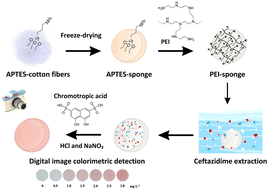Digital image colorimetric detection of ceftazidime based on azo compound formation on a polyethyleneimine-modified cotton sponge†
Abstract
A novel colorimetric platform using cotton sponges modified with polyethyleneimine (PEI) was fabricated for the detection of ceftazidime through the diazotization and coupling reaction. In this work, cotton sponges were initially prepared by freeze drying using 2 w/w% cotton fibers modified with 3-aminopropyl triethoxysilane (APTES), followed by grafting of PEI through a crosslinking reaction using epichlorohydrin (ECH). The optimal concentrations of modifying agents were 170 mM APTES for 1.0 g of cotton fibers and 210 μM PEI for 0.5 g of APTES sponges. With a sample volume of 150 mL, the extracted ceftazidime was detected through the reactions with 0.5 M HCl, 30 mM NaNO2, and 25 μM chromotropic acid on the sponge surface. The PEI-sponge platform provided good selectivity and sensitivity for ceftazidime determination within 30 min. The linear working range for ceftazidime determination was in the range of 0.5–3.0 mg L−1 with a limit of detection (LOD) of 0.06 mg L−1. The proposed method was successfully applied to detect ceftazidime in water samples with satisfactory recovery (83–103%) and reproducibility (<4.76% RSD).



 Please wait while we load your content...
Please wait while we load your content...